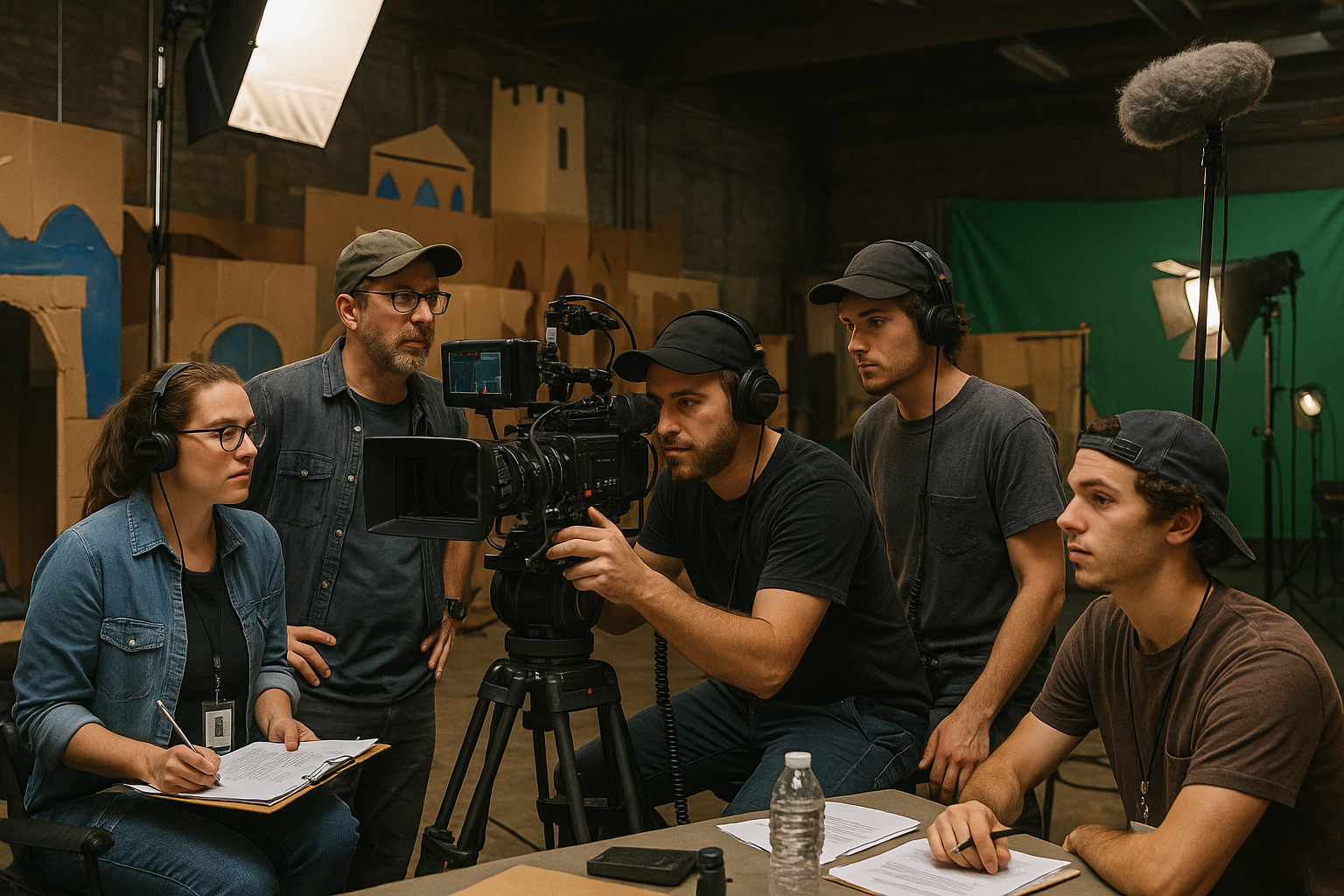🎬 Imagine a scene: A group of enthusiastic filmmakers, armed with a brilliant script, a passionate crew, and a dream. They’re ready to create a cinematic masterpiece but there’s one slight problem—they’re on a tight budget. If you’ve found yourself in this situation, you’re not alone. Making a blockbuster on a budget can seem like a monumental challenge, but with a little ingenuity and a lot of determination, it’s entirely possible.
This blog post is here to guide you through this exciting journey. We’re going to delve deep into the world of budget-friendly filmmaking, sharing practical tips, expert insights, and success stories to inspire you to turn your big screen dreams into reality without breaking the bank.
In the following sections, we’ll be exploring topics like pre-production planning, efficient resource management, smart casting choices, and the importance of post-production. So, fasten your seatbelts because we’re about to embark on an exciting voyage through the realm of affordable filmmaking. 🎥
So, What’s In The Frame?
We’ll begin by decoding the initial steps of the filmmaking process—pre-production planning. We’ll learn how meticulous planning and smart scriptwriting can set the stage for an efficient shoot. We’ll also understand why investing time in storyboarding and location scouting can save considerable costs.
Next, we’ll move to the importance of efficient resource management. We’ll explore how to make the most of your available resources, without compromising on the quality of your film. We’ll discuss tips to manage your budget effectively, from the props to the camera gear, and even the crew.
Casting is a crucial aspect of filmmaking, and we’ll discuss how to make the right choices within your budget. We’ll share insights on looking beyond traditional casting methods and tapping into the pool of emerging talent that can add immense value to your project.
Lastly, we’ll highlight the significance of post-production in the budget filmmaking process. We’ll discuss how to create an impactful narrative through editing, and how to enhance the visual appeal of your film without spending a fortune.
Each section will be filled with actionable tips, backed by real-life examples from successful budget films. We’ll also bring in expert commentary from seasoned professionals in the field to provide you with a comprehensive understanding of the process.
Whether you’re an aspiring filmmaker looking to create your first short film, or an experienced director planning your next big project, this blog post is designed to equip you with the tools you need to create a blockbuster on a budget. 🌟
Remember, filmmaking is an art, and budget constraints can often stimulate the most innovative solutions. So, let’s dive in, explore the possibilities, and turn your filmmaking dreams into reality.
🎥 Lights, Camera, Action: Building Your Vision
What if I told you that you could make a cinematic masterpiece with the resources you have at your disposal? It might sound like a fantasy, but with the right understanding of filmmaking fundamentals, even the most limited budgets can yield remarkable results. In this piece, we’ll demystify the process, providing you with the knowledge you need to create the film of your dreams on a shoestring budget.
The core tenet of low-budget filmmaking is knowing how to effectively manage the resources you have. It’s about making strategic decisions based on what’s available to you, whether it’s equipment, locations, or even the cast. The key is to understand that constraint can often breed creativity and knowing how to leverage that to your advantage can set your film apart.
We’ll break down this process into manageable steps, guiding you through pre-production, production, and post-production stages. You’ll learn how to get the most out of your equipment, how to make effective use of your location, how to direct actors on a budget, and much more. So, grab your camera, gather your crew, and let’s embark on this filmmaking journey together!
1. Pre-Production: Laying the Groundwork
The first and perhaps the most crucial phase in low-budget filmmaking is pre-production. This is where you’ll plan everything that will happen during the shoot. It’s a stage that requires meticulous planning, and the more detailed your plan, the smoother your production will go. Here, we’ll look at crucial pre-production tasks, such as scriptwriting, storyboarding, and location scouting.
2. Production: Capturing Your Vision
The production phase is where you’ll bring your vision to life. However, shooting on a budget means you’ll need to be strategic about how you utilize your resources. We’ll discuss ways to maximize your equipment, make the best use of natural light, and direct your actors to bring out their best performances.
Video: “Low Budget Filmmaking Tips And Advice” by D4Darious
3. Post-Production: Refining Your Masterpiece
The final stage in the filmmaking process is post-production. This is where you’ll edit your footage, add sound and visual effects, and finalize your film. Even on a budget, there are numerous tools and software available that can help enhance your film and give it a professional touch.
🎬 Maximizing Your Resources: The Art of Low-Budget Filmmaking
When it comes to low-budget filmmaking, the key is to make the most out of what you have. You might not have the luxury of a full crew or high-end equipment, but with creativity and resourcefulness, you can still create a cinematic experience that resonates with your audience. Let’s explore the different ways you can maximize your resources during the filmmaking process.
1. Equipment: Making the Most of What You Have
You don’t need a high-end camera to make a good film. In fact, many successful filmmakers have shot their films using affordable DSLRs or even their smartphones. The important thing is knowing how to make the most out of your equipment. Learn about your camera’s settings, experiment with different lenses, and don’t underestimate the power of a good tripod.
Table: Comparison of Low-Cost Filmmaking Equipment
2. Location: Utilizing Spaces Creatively
When it comes to locations, it’s all about using what’s available to you in the most creative way possible. Instead of renting out expensive locations, consider using public spaces, friends’ houses, or even your own home. The key is to think outside the box and find unique ways to present these locations on screen.
3. Cast and Crew: Working with What You’ve Got
Working with a small cast and crew can be challenging, but it can also be a blessing in disguise. With a smaller team, you can develop a close-knit working environment, leading to better communication and collaboration. Plus, you’ll be able to spend more time with each actor, helping them to deliver their best performances.
🎞 From Concept to Screen: The Filmmaking Process
Understanding the filmmaking process is crucial for any aspiring filmmaker, regardless of the budget. From developing a unique concept to the final edits, each stage of the process plays a vital role in bringing your vision to life. Here, we’ll guide you through the filmmaking process, providing tips and advice to help you create a standout film on a budget.
1. Concept Development: Crafting a Unique Story
Every great film starts with a great story. But coming up with a unique concept can be challenging, especially when working with limited resources. However, remember that some of the most successful films have been built around simple ideas. The key is to develop a story that resonates with your audience, regardless of its scale or complexity.
2. Pre-Production: Planning for Success
Pre-production is all about planning. This includes everything from scriptwriting and casting to location scouting and scheduling. The more detailed your pre-production plan, the smoother your shoot will go. Remember, “failing to plan is planning to fail.”
3. Production: Bringing Your Vision to Life
The production phase is where all your planning comes to fruition. This is where you’ll shoot your scenes, direct your actors, and capture your vision on camera. It’s crucial to remain flexible during this stage, as things rarely go exactly as planned. However, with good planning and a positive attitude, you can navigate any obstacles that come your way.
4. Post-Production: Polishing Your Film
Post-production is where you’ll refine your film, cutting and editing the footage, adding sound and visual effects, and finalizing your film. It’s a meticulous and often time-consuming process, but it’s also where your film really comes together. So take your time, pay attention to detail, and don’t rush the process.
📽 Lights, Camera, Action: Tips for Successful Low-Budget Filmmaking
By now, you should have a good understanding of how to make a film on a budget. But before we wrap up, let’s go over some final tips and advice to help you create a successful low-budget film.
1. Embrace Your Limitations
Remember, limitations can breed creativity. Instead of seeing your budget constraints as a hindrance, embrace them as an opportunity to think outside the box and create something truly unique.
2. Plan, Plan, Plan
Planning is crucial in low-budget filmmaking. The more detailed your pre-production plan, the smoother your shoot will go. So take the time to plan out every detail, from your script and storyboards to your shooting schedule and shot list.
3. Be Flexible
Things rarely go exactly as planned during a film shoot. Be prepared to adapt and make changes on the fly. The more flexible you are, the better equipped you’ll be to handle any surprises that come your way.
So what are you waiting for? It’s time to grab your camera, gather your crew, and start making the film of your dreams. Remember, it’s not about the size of your budget, but the size of your imagination. So lights, camera, action – let’s get filming!
Video: “How to Make a Film on a Small Budget” by The Film Look

Conclusion
To conclude, we have ventured into the in-depth technicalities of software engineering and information technology, shedding light on concepts that may seem abstruse to many. This detailed exploration reaffirms that these disciplines are the bedrock of the modern digital era, and their importance cannot be overstated.
In this journey, we took a deep dive into the intricate elements of coding, and how languages like Python and JavaScript are the underpinning of the software world. We understood the notion of coding as a form of communication with machines, translating human ideas into instructions that machines can execute.
We have also discussed the various layers of software development, including front-end, back-end, and full-stack development. We saw how each layer adds a level of complexity, and how the convergence of these layers results in the creation of robust, user-friendly software applications.
Moreover, we touched upon the significance of data analysis in making strategic decisions. We learned how raw data is transformed into meaningful insights using advanced tools and techniques, and how these insights are leveraged to drive business growth.
A special highlight of our discussion was the role of cybersecurity in safeguarding our digital assets. In the era of widespread data breaches and hacking attacks, understanding and implementing cybersecurity measures is no longer an option but a necessity.
The article aimed to provide a comprehensive understanding of these complex technical concepts. However, remember, these are vast fields with continuous advancements. Therefore, it’s crucial to keep learning and updating your knowledge.
In the spirit of knowledge sharing, I encourage you to comment with your thoughts, insights, or questions about these topics. Feel free to share this article with others who might benefit from it. And most importantly, apply what you learned today in your professional life.👩💻🌐🚀
For further reading, I recommend these resources:
Python Official Website
JavaScript Official Website
W3Schools Online Web Tutorials
KrebsonSecurity
Let’s continue to explore, learn, and grow in our respective technical fields. Knowledge, after all, is the key to unlock the doors of advancement.
Here’s to our journey of continual learning and exploration! 🚀🎓🌐
References:
Python.org
Javascript.com
W3Schools.com
KrebsonSecurity



